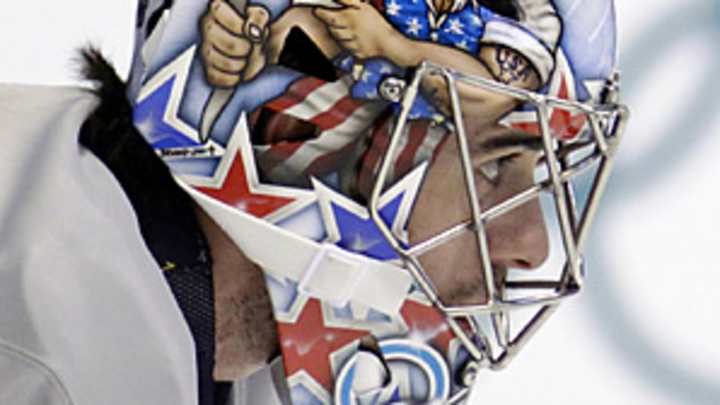Will these Games be Miller Time? U.S. hockey hopes so

There will be some editing on the mask before Team USA opens the 2010 Olympic men's tournament Tuesday against Switzerland, the bane of all works of art. (Editing. Not the Swiss.) The bit about Miller Time is out according to the Miss Grundys of the International Olympic Committee, who howl whenever they see a possible commercial link befouling their Games -- at least one from which they aren't getting a cut. The Matt Man tribute to his cousin, Matt Schoals, who died in 2007 of leukemia at age 19, also will be excised if the IOC gets its way, but the starting American goalie will arm wrestle the logo police to the finish in order to keep it. "(This is) for my aunt and uncle, for my family," he said. "It's important to them and important to me." The Olympic rings and the Vancouver logo are still up in the air. The shamrock on the front, an homage to Miracle on Ice goalie Jim Craig, who had them on his mask in 1980, is in.
But of all the bold pictures and stirring words and enduring symbols that grace this mask, the one thing a paint brush should absolutely not be allowed to touch is Ryan Miller's kick-butt Uncle Sam.
Ryan Miller, Uncle Sam Needs You!
The conventional wisdom is these Olympics will be a goaltenders' tournament, a six-game sprint to gold that will turn on the play of a goalie. "That's because it's really hard to play well defensively and cohesively in less than a week, and your goalie is going to be called upon to bail you out in certain situations," Team USA coach Ron Wilson said. "Everyone knows that (the effectiveness of your) penalty killing is due largely to how well the goalies play and your offense ... if you believe your goaltender can handle two-on-ones and three-on-twos, you take your chances up ice. It leads to better offense. I think our players really trust Ryan." These words are as pretty as the mask, and they might even prove true. But conventional wisdom is batting .333 in the three Olympics that have featured NHL players. The initial tournament, Nagano 1998, did belong to a goalie, Dominik Hasek of the Czech Republic, who foiled all five Canadian shooters in the shootout to win a 2-1 semifinal match and then shut out Russia, 1-0, in the final. But other than Sweden's Tommy Salo ignobly ducking on a shot in Salt Lake City 2002 that led to Belarus' quarterfinal upset that was every bit as stunning as the Miracle on Ice, goaltending was not the tournament fulcrum. Martin Gerber's 49-save whitewash of Canada was a genuine goalie moment in Turin 2006, but the turning point of the gold-medal match was Finland's Saku Koivu breaking his stick on the faceoff to start the third period. Go figure. As Team USA veteran Chris Drury noted Monday, "You always think it'll it be pitching that determines a baseball game or quarterbacking a football game. You know, sometimes it does. Sometimes it doesn't."
But of all those with a grand shot at a medal -- this typist is guessing the U.S. will win bronze, behind Canada and Russia -- the team most in need of stellar goaltending probably is Uncle Sam's hockey heroes. Not that this small, quick team is callow, but those five interlocking rings that were originally painted on the chin of Miller's mask might as well represent teething rings. Thirteen of the 23 players on Team USA are 25 or younger. After squeezing all that it could out of the fabulous American players that starred in the mid-1990s, USA Hockey finally decided it needed a change for Vancouver. Who knew the change would involve a whole shipment of Pampers?
(If that is not the official plastic diaper of Vancouver 2010, our most humble apologies.)
To extend the scatological analogy, younger players make mistakes that force a goalie to clean up the mess. Says Team USA general manager Brian Burke of Miller, "He's compact. He conserves energy. With a young team, having a goalie who's not Denis Lemieux from Slap Shot, flopping around and screaming, is good. It's good to have a guy who's reserved. Calm is an asset." Three-quarters through the NHL season, no goalie has been consistently better. Despite hitting an icy patch in mid-January through early February -- Miller had two wins in 11 games while stopping a middling 91.1 percent of shots in one stretch -- his body of work, as Burke notes, has been superior to all the other masked men. Wilson actually called Miller at halftime of the Super Bowl to inform him officially that he would be the starter, not that there ever was a scintilla of doubt. The conversation was so brief, Miller, hanging out at a party at Sabres teammate Craig Rivet's house, caught almost all of The Who.
"From my perspective, I just want to do what I've always done -- just giving the guys a chance to win," Miller said. "Being in the right position. I'm not going to change the way I play. I'm not all of a sudden being a guy who sits back in the net and tries to make big glove saves all the time. I'm going to be out challenging ... Getting hit square in the chest a lot. That's what pretty much makes me a good goaltender. Making guys change their minds. Making guys miss the play they might want to make."
In the next fortnight, America will find out if this truly is Miller Time, no matter what his mask winds up advertising. And if he does steal a game or maybe even a gold medal, he will end up in the U.S. Hockey Hall of Foam. Er, Fame.
